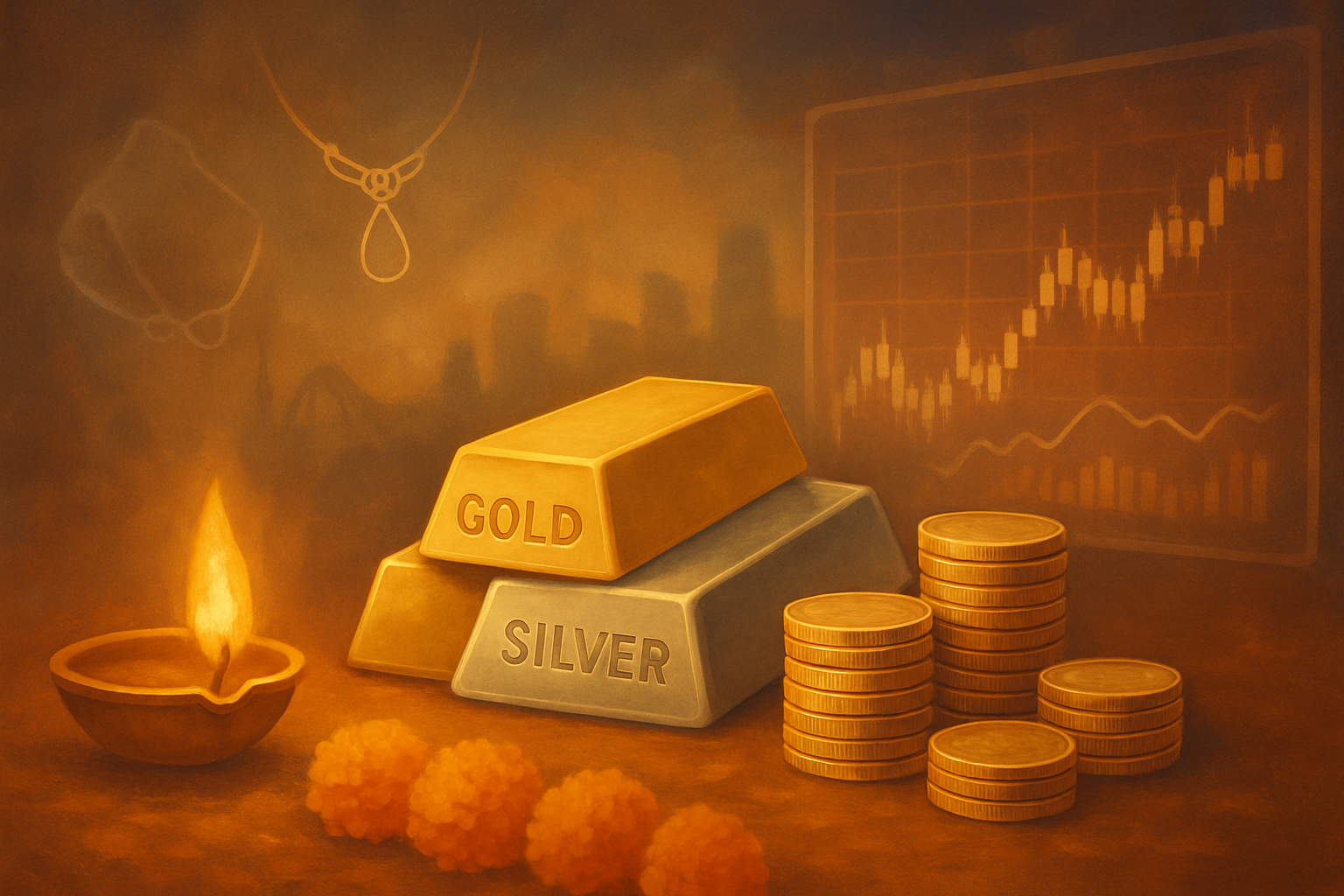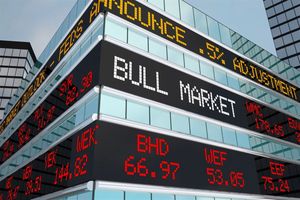
Mumbai, India – October 17, 2025 – As India gears up for its auspicious festive season, with Dhanteras (October 18, 2025) marking the beginning of the five-day Diwali celebrations, the nation's traditional fervor for gold and silver is colliding with unprecedented market realities. Record-high prices for both precious metals are reshaping consumer preferences and creating a unique dynamic in the Indian bullion market. While the cultural significance of purchasing gold and silver during this period remains undiminished, a noticeable shift towards more affordable options, investment-grade bullion, and even alternative metals like platinum is emerging, prompting jewelers and investors alike to adapt to a rapidly evolving landscape.
The immediate implications for the precious metal market are profound. Prices for gold have soared past ₹1.3 lakh per 10 grams (24K), while silver has emphatically breached the ₹2 lakh per kilogram threshold in many key Indian markets. This dramatic surge, fueled by a confluence of global geopolitical tensions, economic uncertainties, central bank buying, and robust domestic demand, is setting the stage for a festive season unlike any before. The traditional gold rush is now accompanied by cautious optimism and strategic buying, as consumers navigate elevated costs and explore new avenues to uphold their cultural traditions of prosperity and good fortune.
Unprecedented Price Rally Redefines Festive Buying Traditions
The current festive season is unfolding against a backdrop of historic price movements in the precious metal markets. Gold has delivered substantial gains, rising approximately 66% since last Dhanteras (October 2024), with a significant 58% increase occurring in the first ten months of 2025 alone. Silver has witnessed an even more dramatic rally, nearly doubling its price year-on-year, with a staggering 98% spike since last Dhanteras. This meteoric rise is driven by a complex interplay of global and domestic factors.
Globally, escalating geopolitical tensions, particularly US-China trade friction, coupled with fears of recession and broader economic uncertainty, have bolstered gold's traditional role as a safe-haven asset. Increased purchases by central banks worldwide, a weakening US dollar, and expectations of future interest rate cuts by the US Federal Reserve have further propelled prices. Domestically, strong physical demand during Dhanteras and Diwali, combined with a "fear of missing out" (FOMO) among buyers, has exacerbated the rally. The depreciation of the Indian Rupee against the US Dollar has also amplified gold returns in Rupee terms, making it an attractive investment.
Silver's exceptional performance, outstripping gold in percentage terms, is particularly noteworthy. Its rally is fueled not only by its safe-haven appeal but also by robust industrial demand from burgeoning sectors such as electronics, renewable energy (e.g., solar photovoltaic panels), and electric vehicles. Global supply shortages and tight inventories are significant factors, positioning silver as a more accessible alternative to gold for many retail investors, despite its own soaring premiums. Some jewelers are even reporting an acute scarcity of physical silver, leading to premiums of up to ₹30,000 per kilogram over official rates and temporary halts on fresh silver orders for the festive season.
These unprecedented price levels are profoundly altering traditional buying patterns. Demand for conventional gold jewelry has reportedly declined, with some retailers experiencing up to a 50% fall in sales in this segment. Consumers are increasingly opting for lightweight jewelry or smaller units of investment gold. There's a noticeable shift towards purchasing gold bullion products like bars and coins for investment purposes, with some jewelry stores reporting shortages. The "financialization" of gold is also leading to increased demand for digital gold and Gold Exchange Traded Funds (ETFs), allowing consumers to invest in smaller denominations without the need for physical storage. This shift indicates a growing pragmatism among Indian consumers, balancing cultural traditions with financial prudence.
Jewelers and Financial Institutions Navigate Shifting Sands
The current market dynamics present a mixed bag of opportunities and challenges for key players in the Indian precious metals sector. Jewelers, traditionally the primary beneficiaries of festive season demand, are experiencing significant shifts in consumer behavior. Companies like Titan Company Limited (NSE: TITAN), a major player with its Tanishq brand, and PC Jeweller Ltd. (NSE: PCJEWELLER) are likely to see a divergence in their product segment performance. While demand for heavy, traditional gold jewelry may soften, there's an anticipated uptick in sales of lighter, more contemporary designs and investment-grade products like gold coins and bars. Jewelers who have diversified their offerings to include platinum jewelry, digital gold options, and silver articles are better positioned to capture the evolving market. The acute scarcity and high premiums on physical silver could, however, impact their ability to meet demand for silver products, potentially leading to lost sales or reduced margins.
On the other hand, financial institutions offering gold-related investment products stand to gain. Banks and platforms providing digital gold services, such as Augmont Gold For All or MMTC-PAMP, as well as asset management companies managing Gold Exchange Traded Funds (ETFs) like those offered by Nippon India Mutual Fund (NSE: NIPPINVEST) or ICICI Prudential Asset Management Company, are likely to see increased traction. The "financialization" of gold appeals to a segment of consumers looking to invest in gold without the burden of storage or making charges, especially given the high physical prices. These platforms offer convenience and liquidity, attracting a new generation of investors and those seeking to capitalize on gold's upward trajectory without direct physical purchases.
Furthermore, companies involved in the supply chain of precious metals, including refiners and importers, face both opportunities and challenges. While sustained high prices generally indicate strong underlying demand, the volatility and the specific scarcity of physical silver could create procurement and inventory management hurdles. Firms with robust supply chain networks and hedging strategies will be better equipped to navigate these fluctuating conditions. The overall bullish sentiment for precious metals, however, suggests a favorable environment for those dealing in bullion, provided they can manage the operational complexities of a high-priced, high-demand market.
Broader Implications: A New Era for Precious Metals in India
The unique dynamics of India's 2025 festive season are not isolated incidents but rather reflective of broader, long-term trends reshaping the global and domestic precious metal markets. The sustained high prices for gold and silver underscore a fundamental shift in their perceived value, moving beyond mere adornment to solidify their status as critical investment and industrial assets. This event fits into a global narrative of increasing economic uncertainty, inflation concerns, and geopolitical instability, all of which historically bolster demand for safe-haven assets.
The noticeable shift in consumer preferences, particularly the move towards lighter jewelry, investment-grade bullion, and digital gold, signifies a maturation of the Indian market. It suggests that while cultural traditions remain strong, consumers are becoming more financially savvy, seeking value and investment returns alongside traditional purchases. This trend could accelerate the "financialization" of gold in India, with a greater proportion of demand channeled through ETFs, digital platforms, and gold bonds rather than purely physical jewelry. This could also have ripple effects on international gold markets, as India, one of the largest consumers, adjusts its buying patterns.
Regulatory bodies might also take note of the evolving market. The increased financialization could prompt discussions around standardizing digital gold platforms, strengthening consumer protection for online precious metal investments, and potentially reviewing import duties or taxes in response to price volatility and supply challenges. The acute scarcity of physical silver and the resulting high premiums could attract regulatory scrutiny to ensure market transparency and prevent exploitation. Historically, periods of high demand and price volatility have often led to policy adjustments aimed at stabilizing markets and protecting consumer interests.
Comparisons to past festive seasons reveal a consistent pattern of increased demand, but the magnitude of the current price rally and the explicit shift in consumer behavior mark a significant divergence. While previous price surges have also led to some moderation in jewelry buying, the current environment, exacerbated by global factors, seems to be driving a more structural change. The growing industrial demand for silver, particularly from green technologies, adds another layer of complexity, intertwining India's festive buying with global technological advancements and supply chains. This confluence of factors suggests that the current trends are not merely cyclical but indicative of a long-term recalibration of India's relationship with precious metals.
The Road Ahead: Adaptation and Innovation Define the Future
Looking ahead, the Indian precious metal market faces a period of continuous adaptation and innovation. In the short term, the sustained festive buying is expected to keep gold and silver prices elevated, potentially leading to further volatility. However, experts caution about a potential post-festive correction as profit-taking sets in and global economic conditions possibly stabilize. Investors should remain vigilant, avoiding short-term speculation and focusing on long-term investment strategies. The acute scarcity of physical silver is likely to persist, maintaining high premiums and posing ongoing sourcing challenges for jewelers and industrial users.
In the long term, the "financialization" of gold is set to deepen. We can anticipate further growth in digital gold platforms, Gold ETFs, and sovereign gold bonds as consumers increasingly view precious metals as investment vehicles rather than solely as ornaments. This shift will require jewelers to strategically pivot, emphasizing lighter, more affordable designs, offering customization, and integrating digital sales channels. The rise of platinum as a viable alternative, particularly for younger demographics and those seeking modern aesthetics, will also gain momentum, challenging gold's traditional dominance in the bridal and gifting segments. Jewelers who embrace these trends by expanding their platinum offerings and promoting its unique properties will find new market opportunities.
Market opportunities will emerge for companies specializing in recycled gold and silver, as high prices make sourcing from existing supplies more attractive. Furthermore, innovation in product design, focusing on modular jewelry or pieces that offer multiple uses, could cater to the evolving consumer who seeks both value and versatility. Challenges will include managing inventory amidst price volatility, navigating potential supply chain disruptions, and adapting marketing strategies to appeal to a more financially conscious consumer base. Potential scenarios range from continued price rallies driven by persistent global uncertainty to a stabilization of prices if geopolitical tensions ease and economic growth strengthens. However, the underlying strong demand from India, coupled with global factors, suggests a bullish long-term outlook for both gold and silver.
A Golden Reset: Navigating India's Evolving Precious Metal Market
The 2025 Indian festive season marks a significant turning point for the nation's precious metal market. The confluence of record-high prices and evolving consumer preferences has initiated a "golden reset," challenging traditional buying patterns and accelerating the modernization of how Indians engage with gold and silver. Key takeaways include the robust, albeit price-driven, demand for precious metals, the distinct shift towards investment-grade products and lighter jewelry, and the emerging role of platinum as a compelling alternative. The exceptional performance and scarcity of silver also highlight its growing importance, not just as a precious metal but as a critical industrial commodity.
Moving forward, the market will likely remain dynamic and sensitive to global macroeconomic indicators, geopolitical developments, and industrial demand trends. For investors, the long-term bullish outlook for gold and silver remains strong, with analysts predicting further price increases into 2026 and 2027. Market dips might present opportune buying moments, but caution is advised against short-term speculation. Retailers, particularly jewelers, must continue to adapt by diversifying their product offerings, embracing digital solutions, and understanding the nuanced preferences of a consumer base that is increasingly balancing cultural reverence with financial pragmatism.
The lasting impact of this festive season will be the acceleration of structural changes in the Indian precious metal market. It underscores a fundamental re-evaluation of value, utility, and investment potential. Investors should watch for continued trends in digital gold adoption, the performance of platinum jewelry, and any regulatory responses to market volatility or supply chain issues. The Indian festive season of 2025 will be remembered not just for its record prices, but as a pivotal moment that redefined the nation's enduring love affair with gold and silver, ushering in an era of more sophisticated and diverse engagement with these cherished assets.
This content is intended for informational purposes only and is not financial advice





